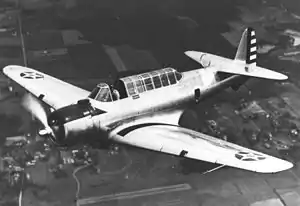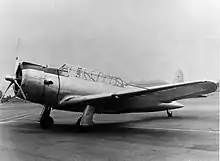Vultee V-11
The Vultee V-11 and V-12 were American stressed-skin monocoque monoplane attack aircraft of the 1930s. Developed from the Vultee V-1 single-engined airliner, the V-11 and V-12 were purchased by several nation for their armed forces, including China, who used them in combat against Japanese forces in the Second Sino-Japanese War. The United States Army Air Corps purchased seven V-11s as the YA-19 in the years before World War II, testing them to gather data to compare against twin engine light attack aircraft.
| V-11/V-12 | |
|---|---|
 | |
| Role | Ground attack |
| Manufacturer | Vultee |
| Designer | Gerard Freebairn Vultee[1] |
| First flight | 17 September 1935[2] |
| Introduction | 1937 |
| Status | retired |
| Primary users | Republic of China Air Force Turkish Air Force Soviet Air Forces Brazilian Army Aviation |
| Produced | 1935–1940[3] |
| Number built | 175+[4][notes 1] |
| Developed from | Vultee V-1 |

Design and development
In 1935, Vultee produced a light bomber derivative of their single-engined passenger transport, the Vultee V-1, which, while demonstrating good performance, was only sold in small numbers owing to restrictions placed on the use of single-engined aircraft for scheduled passenger transport operations.[5]
The resulting aircraft, the Vultee V-11, retained the single-engined, low wing format and all-metal stressed skin structure of the V-1. It combined a new fuselage with accommodation for the three crew members under a long greenhouse canopy with the wings and tail surfaces of the Vultee V-1.[6]
Operational history
China
.jpg.webp)
An initial order for 30 two-seat V-11Gs was placed by China before the end of 1935. This was followed by orders in 1939, for two versions (the V-12-C and V-12D) of the more powerful V-12 variant. The majority of these were planned to be assembled from kits at the Central Aircraft Manufacturing Company factory at Loiwing near the China-Burma border,[7] and while the first batch of 25 V-12-Cs were completed successfully, the factory was heavily bombed just after assembly of the first V-12-Ds commenced. This resulted in the part built airframes being evacuated to India, where it was planned that the aircraft be completed at the Hindustan Aircraft Limited factory in Bangalore. However, after a few were assembled, production was stopped as the factory was diverted to more urgent overhaul work.[8]
The V-11s and V-12s were used as light bombers and achieved some success, including a mission to bomb the Japanese held airfield by 4 aircraft at Yuncheng on February 5, 1939, by the 10th Squadron of the Republic of China Air Force, before the aircraft were withdrawn from bombing missions to training and liaison duties in 1940.[9]
Brazil
.jpg.webp)
In February 1939, the Brazilian Army Air Corps acquired the first 10 Vultee V-11–GB2s for long range bombing. 26 aircraft were eventually used by the Brazilian Air Force.
A 3,250 km (2,020 mi) non-stop flight was made across the Brazilian hinterland in 11 hours and 45 min on 8 November 1939 using a V-11.
On 26 August 1942, a U-boat was attacked 50 miles off the town of Ararangua off the southern coast of Brazil. Despite the unsuitability for anti submarine operations, the aircraft flew low and dropped its load of three 250 lb (110 kg) bombs, some of which exploded around the submarine, however the blast damaged the low flying aircraft.
Soviet Union

In 1936, the Soviet Union purchased four three-seat V-11-GB aircraft, together with a production license. The aircraft entered Soviet production in 1937 as the BSh-1 (Bronirovanny Shturmovik), but the armour fitted for the ground attack role unacceptably reduced performance and production was stopped after 31 aircraft. They were transferred to Aeroflot and redesignated PS-43 for use as high speed transports until the German invasion in 1941, when they were returned to the Air Force for liaison purposes.[10]
United States
.jpg.webp)
In the late 1930s, the United States Army Air Corps favored twin-engine light attack aircraft but seven YA-19 aircraft were ordered in the summer of 1938 for comparison purposes. The YA-19s were armed with six .30 in (7.62 mm) machine guns and 1,080 lb (490 kg) bombs in an internal bomb bay, powered by a 1,200 hp (890 kW) Twin Wasp radial engine and was manned by a crew of three including a pilot, observer/gunner, and bombardier/photographer.
An unusual feature of the YA-19 design was its horizontal stabiliser which was located forward of the vertical tail. The small size of the vertical stabilizer caused yaw instability so the last YA-19 (S/N 38-555) was equipped with enlarged vertical stabilizer.
Service tests showed that twin-engine attack aircraft were faster, could be better armed and carried a larger bomb load so no further YA-19s were ordered. After comparison tests five YA-19s were redesignated A-19 and assigned to the 17th Attack Group at March Field in California for a brief period before being transferred to the Panama Canal Zone for utility transport and liaison duties. The A-19 never saw combat and was quickly withdrawn in the early 1940s.
Variants
Vultee Designations
- V-11
- First prototype fitted with 750 hp (560 kW) Wright SR-1820-F53 Cyclone driving a two-bladed Hamilton Standard controllable-pitch propeller, which crashed killing both pilot and the project engineer.[2]
- V-11-A
- Second prototype, similar to first V-11, but with a three-bladed constant speed propeller.

.jpg.webp)
- V-11-G
- Initial production two-seat light bomber. Powered by an 850 hp (630 kW) Wright R-1820-G2 Cyclone engine. 30 built for China.[11]
- V-11-GB
- Three-seat version of V-11. 4 aircraft purchased by Soviet Union (2 as pattern aircraft), 40 by Turkey and others.[12]
- V-11-GB2
- 26 purchased by Brazil – generally similar to V-11-GB[12]
- V11-GB2F
- Final example for Brazil fitted with floats, however it wasn't accepted.[12]
- V-11-GBT
- redesignation of V-11-GB for Turkey
- V-12
- Revised version of three-seat bomber with refined aerodynamics and more power. One prototype flew in 1939 powered by Pratt & Whitney R-1830 Twin Wasp engine.
- V-12-C
- Production version of V-12 for China. Powered by R1820-G105B Cyclone engine. 26 built, one by Vultee and remaining 25 assembled in China.
- V-12-D
- Revised version with new fuselage and powered by 1,600 hp (1,200 kW) Wright R-2600 Cyclone 14 engine. 52 ordered for China, two pattern aircraft built by Vultee and 50 for local assembly.
- V-52
- Unbuilt observation design based on YA-19.
USAAC Designations

- YA-19
- Variant of V-11-GB for United states Army Air Corps. Seven examples built.
- YA-19A
- The last YA-19 was redesignated and completed as an engine test bed. Equipped with enlarged vertical stabilizer (for improve directional stability) and powered by Lycoming O-1230 (12-cylinder opposed) engine.
- YA-19B
- The second YA-19 built was redesignated after being fitted with a Pratt & Whitney R-2800 radial engine as an engine test bed.
- YA-19C
- The YA-19A was redesignated after being fitted with a Pratt & Whitney Twin Wasp R-1830-51 engine. Performance was similar to the YA-19.
- A-19
- The remaining five YA-19s were redesignated A-19 after assignment to active duty.
Operators

 Brazil
Brazil- Brazilian Army Aviation – Vultee V-11-GB2 (25 delivered)[12]
- Brazilian Air Force - aircraft transferred when Air Force created
 Republic of China
Republic of China
 Soviet Union
Soviet Union- Soviet Air Forces – Vultee V-11GB (4 delivered) & BSh-1 (31-35 built at Moscow Menzhinskii factory)[12]
 Turkey
Turkey
- Turkish Air Force
- 2nd Regiment – Vultee V-11GB (41 delivered)[12]
 United States
United States- United States Army Air Corps – A-19/V-11GB (7 delivered)[12]
Specifications (Vultee XA-19)

Data from U.S. Experimental & Prototype Aircraft Projects[14]
General characteristics
- Crew: Three (pilot, observer/gunner and bombardier/photographer)
- Length: 37 ft 10 in (11.53 m)
- Wingspan: 50 ft 0 in (15.24 m)
- Height: 10 ft 0 in (3.05 m)
- Wing area: 384 sq ft (35.7 m2)
- Airfoil: Clark Y[15]
- Empty weight: 6,452 lb (2,927 kg)
- Gross weight: 10,420 lb (4,726 kg)
- Max takeoff weight: 16,285 lb (7,387 kg)
- Fuel capacity: 311-330 gallons
- Powerplant: 1 × Pratt & Whitney R-1830-17 Twin Wasp 14-cylinder two-row air-cooled radial engine, 1,200 hp (890 kW)
- Propellers: 3-bladed Hamilton Standard variable-pitch propeller
Performance
- Maximum speed: 230 mph (370 km/h, 200 kn) at 6,500 ft (2,000 m)
- Cruise speed: 207 mph (333 km/h, 180 kn)
- Minimum control speed: 80 mph (130 km/h, 70 kn)
- Range: 1,110 mi (1,790 km, 960 nmi) with 1,080 lb (490 kg) of bombs
- Ferry range: 1,350 mi (2,170 km, 1,170 nmi)
- Service ceiling: 20,500 ft (6,200 m)
- Rate of climb: 1,320 ft/min (6.7 m/s)
Armament
- Guns:
- 4 x forward-firing .30 in (7.62 mm) machine guns in wings
- 1 x dorsal .30 in (7.62 mm) machine gun
- 1 x ventral .30 in (7.62 mm) machine gun
- Bombs: 6 x 30 lb (14 kg) in cells semi-recessed in wing center section and 1,100 lb (500 kg) externally
See also
Related development
Aircraft of comparable role, configuration, and era
Related lists
References
| Wikimedia Commons has media related to Vultee V-11. |
Notes
- plus as many as 4 more in Russia, and as many as 45 additional airframes that were delivered as parts sets but probably not assembled in China, for a maximum of 224.
Citations
- Baugher, 2000
- Wegg 1990, p. 155
- Wegg 1990, pp. 155–157
- Wegg 1990, pp. 168
- Green and Swanborough Air Enthusiast July 1974, p. 29.
- Green and Swanborough Air Enthusiast July 1974, p. 32.
- Green and Swanborough Air Enthusiast July 1974, p.39.
- Green and Swanborough Air Enthusiast July 1974, p.42.
- Gustavsson, Hakans. "Håkans Aviation page – Sino-Japanese Air War 1939". Biplane Fighter Aces - China. Retrieved 2020-11-19.
05 February 1939. Four Vultees of the 10th BS attacked Yuncheng airfield and dropped 1120 kg of bombs. They returned claiming 10 aircraft destroyed on the ground.
- Green and Swanborough Air Enthusiast July 1974, p.38.
- Wegg 1990, pp. 155–156
- Wegg 1990, p. 156
- Wegg 1990, p. 157
- Norton, 2008, p.182
- Lednicer, The Incomplete Guide to Airfoil Usage, 2010
Bibliography
- Baugher, Joseph F. (1 July 2000). "Vultee XA-19". www.joebaugher.com. Retrieved 3 October 2019.
- Deryakulu, Nejat (November 1995). "Les Vultee V-11GBT turcs" [Turkish Vultee V-11GBTs]. Avions: Toute l'aéronautique et son histoire (in French) (32): 29–32. ISSN 1243-8650.
- Green, William; Swanborough, Gordon (eds.) (July 1972). "Those Versatile Vultees". Air Enthusiast. Vol. 3 no. 1. pp. 27–32, 38–42.CS1 maint: extra text: authors list (link)
- Johnson, E.R. (2008). American Attack Aircraft Since 1926. McFarland. pp. 30-32. ISBN 978-0786434640.
- Lednicer, David (15 September 2010). "The Incomplete Guide to Airfoil Usage". m-selig.ae.illinois.edu. Retrieved 16 April 2019.
- Norton, William (2008). U.S. Experimental & Prototype Aircraft Projects: Fighters 1939-1945. North Branch, MN: Specialty Press. p. 182. ISBN 978-1580071093.
- Swanborough, Gordon; Bowers, Peter M. (1989). United States Military Aircraft Since 1909. Smithsonian. ISBN 978-0874748802.
- Wegg, John (1990). General Dynamics Aircraft and Their Predecessors. Putnam Aviation Series. Putnam/Naval Institute Press. pp. 155-158. ISBN 978-0870212338.